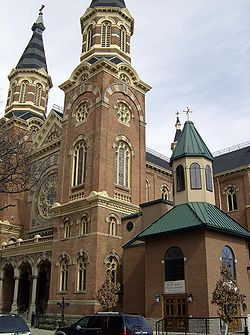
The Archdiocese of Detroit is a Latin Church ecclesiastical territory or archdiocese of the Catholic Church covering the Michigan counties of Lapeer, Macomb, Monroe, Oakland, St. Clair, and Wayne. It is the metropolitan archdiocese of the Ecclesiastical Province of Detroit, which includes all dioceses in the state of Michigan. In addition, in 2000 the archdiocese accepted pastoral responsibility for the Catholic Church in the Cayman Islands, which consists of Saint Ignatius Parish on Grand Cayman.

Grosse Pointe refers to an affluent coastal area next to Detroit, Michigan, United States, that comprises five adjacent individual cities. From southwest to northeast, they are:
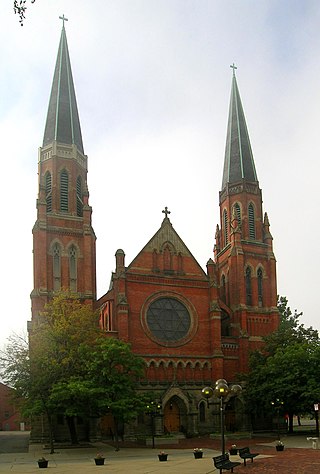
Basilica of Sainte Anne de Détroit (Sainte-Anne-de-Détroit) was founded July 26, 1701 by French colonists in New France, and is the second-oldest continuously operating Roman Catholic parish in the United States. The current Gothic Revival cathedral-styled church, built in 1886, is located at 1000 St. Anne Street in Detroit, Michigan, in the Hubbard-Richard neighborhood, near the Ambassador Bridge, and the Michigan Central Station. At one time it was the seat of a diocese that included French territory in Ontario, Canada south of the Detroit River.

St. Florian Church is a Roman Catholic Church at 2626 Poland Street in Hamtramck, Michigan. The church was designed by Ralph Adams Cram of the firm Cram and Ferguson.

Holy Redeemer High School was a Roman Catholic secondary school located in Southwest Detroit, at the corner of Junction and Vernor streets, near the Ambassador Bridge to Canada. It was overseen by the Archdiocese of Detroit.

The architecture of metropolitan Detroit continues to attract the attention of architects and preservationists alike. With one of the world's recognizable skylines, Detroit's waterfront panorama shows a variety of architectural styles. The post-modern neogothic spires of One Detroit Center refer to designs of the city's historic Art Deco skyscrapers. Together with the Renaissance Center, they form the city's distinctive skyline.
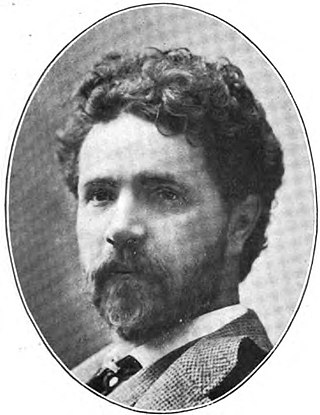
Donaldson and Meier was an architectural firm based in Detroit, Michigan. Founded in 1880 by John M. Donaldson (1854–1941) and Henry J. Meier (1858–1917), the firm produced a large and varied number of commissions in Detroit and southeastern Michigan. Donaldson, the principal designer of the partnership from a design point of view, was born in Stirling, Scotland and immigrated to Detroit at a young age. He returned to Europe where he studied at the Art Academy in Munich, Germany, and at the École des Beaux-Arts in Paris, France.

The Cathedral of the Most Blessed Sacrament is a Neo-Gothic style Roman Catholic cathedral church in the United States. It is the seat of the archbishop of the Roman Catholic Archdiocese of Detroit. The metropolitan archdiocese for the Roman Catholic Ecclesiastical Province of Detroit includes all dioceses in the state of Michigan; in addition, in 2000 the archdiocese accepted pastoral responsibility for the Roman Catholic Church in the Cayman Islands, which consists of Saint Ignatius Parish on Grand Cayman. The cathedral is located at 9844 Woodward Avenue in Detroit, Michigan, adjacent to Detroit's Boston-Edison Historic District. The cathedral was listed on the National Register of Historic Places in 1982.
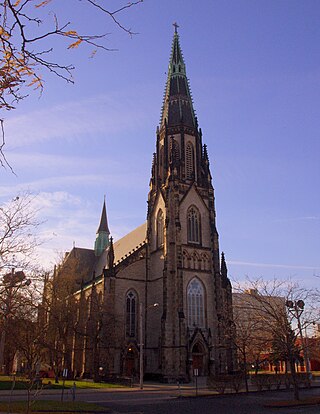
St. Joseph Shrine, founded in 1855, is a historic German Catholic church located at 1828 Jay Street in the Eastern Market–Lafayette Park neighborhood area just outside downtown Detroit, Michigan, on the city's central east side. The building was listed on the National Register of Historic Places in 1972, and deemed "of national importance" because of its stained glass. Three subsidiary buildings—the rectory, convent, and the Wermers House—were added to the listing in 1992. It is under the jurisdiction of the Archdiocese of Detroit, and presently a shrine dedicated to the celebration of the pre-Vatican II liturgy under the care of the canons of the Institute of Christ the King Sovereign Priest.
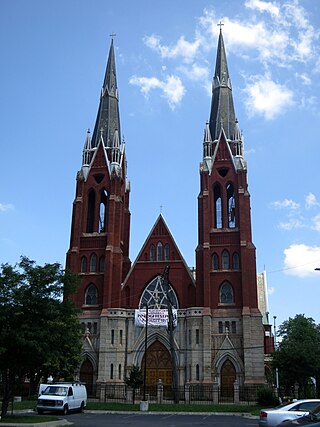
The Sweetest Heart of Mary Roman Catholic Church is located at 4440 Russell Street in Detroit, Michigan, in the Forest Park neighborhood on the city's central East side. The Gothic Revival cathedral styled church is the largest of the Roman Catholic churches in the City of Detroit. It was designated a Michigan State Historic Site in 1974 and listed on the National Register of Historic Places in 1978. It, along with St. Albertus Roman Catholic Church, 0.4 miles east on East Canfield Street, and St. Josaphat Roman Catholic Church, 0.3 miles west at East Canfield Street and Chrysler Drive, served the large Polish community through most of the twentieth century. In a diocesan reorganization instituted by Archbishop Allen Vigneron in 2013, Sweetest Heart of Mary joined with St. Josephat to form Mother of Divine Mercy Parish.

The Sacred Heart Roman Catholic Church, Convent and Rectory is a Roman Catholic church complex located at 1000 Eliot Street in Detroit, Michigan. It was designated a Michigan State Historic Site in 1975 and listed on the National Register of Historic Places in 1980.

The Chapel of St. Theresa–the Little Flower is a church located at 58 Parsons Street in Midtown Detroit, Michigan. It is currently known as St. Patrick Church. The building was listed on the National Register of Historic Places in 1997, and demolished in September 2023.

Sts. Peter and Paul Academy is a Catholic school building located at 64 Parsons Street in Midtown Detroit, Michigan. It currently serves as the St. Patrick Senior Center. It was listed on the National Register of Historic Places in 1997.
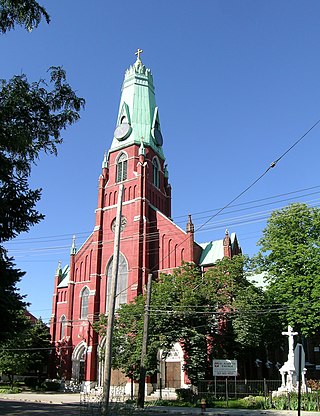
St. Albertus Roman Catholic Church is in the Forest Park neighborhood of Detroit, Michigan. It was designated a Michigan State Historic Site in 1974 and listed on the National Register of Historic Places in 1978.
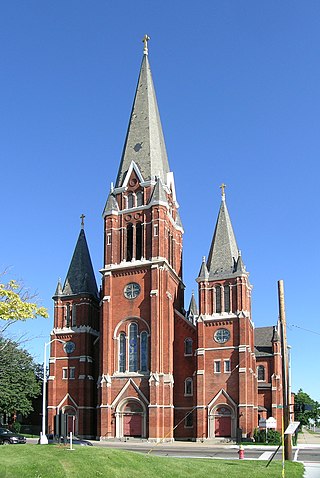
St. Josaphat Roman Catholic Church is a Roman Catholic church located at 715 East Canfield Street in Detroit, Michigan. It was listed on the National Register of Historic Places in 1982 and designated a Michigan State Historic Site in 1985. Since 2013, it has been one of two churches that comprise Mother of Divine Mercy Parish.

St. Charles Borromeo Roman Catholic Church is a church located at the corner of Baldwin Avenue and St. Paul Avenue in Detroit, Michigan. The church address is 1515 Baldwin Street; ancillary buildings are located at 1491 Baldwin Street (Rectory) and 1480 Townsend Street. The complex was listed on the National Register of Historic Places in 1989.

The Assumption of the Blessed Virgin Mary Church is a Catholic church of the Archdiocese of Detroit located at 13770 Gratiot Avenue in Detroit, Michigan. It is commonly known as the Assumption Grotto Church. The church community was founded in the 1830s, and the present building completed in 1929, designated a Michigan State Historic Site in 1990 and listed on the National Register of Historic Places in 1991.

The Most Holy Redeemer Church is located at 1721 Junction Street in Southwest Detroit, Michigan, within the West Vernor–Junction Historic District. The church was once estimated as the largest Roman Catholic parish in North America. West Vernor–Junction Historic District is adjacent to Mexicantown and contains a growing Mexican community and resurgent neighborhood.

The Saint Paul Catholic Church Complex is located at 157 Lake Shore Road in the Detroit suburb of Grosse Pointe Farms, Michigan. The group includes a French Gothic-style church, a Neo-Tudor rectory, a Colonial Revival parish hall, a Neo-Tudor school building, and an Elizabethan Revival convent. The complex was designated a Michigan State Historic Site in 1992 and listed on the National Register of Historic Places in 1994.
